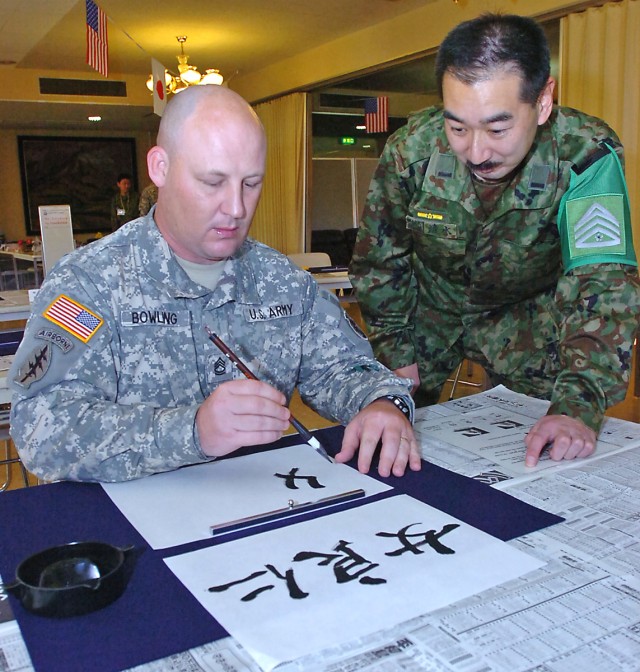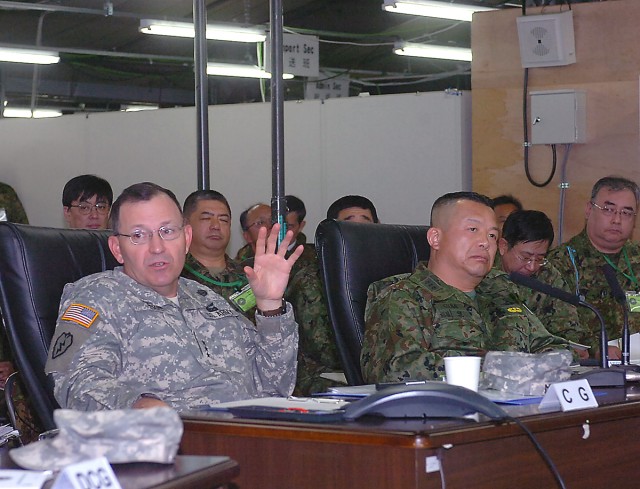CAMP ASAKA, Japan - Over 1,200 U.S. Army Soldiers and nearly 4,500 members of the Japan Ground Self Defense Force conducted exercise Yama Sakura 55 here December 7-14, 2008.
Yama Sakura, which means "mountain cherry blossom," is an annual bilateral exercise designed to strengthen military operations and ties between the U.S. Army and the JGSDF.
"The yearly Yama Sakura exercise has been carried on without interruption for 27 years," said Lt. Gen. Kazushi Izumi, commander of the JGSDF Eastern Army, in a ceremony December 7. "I firmly believe that this exercise holds great significance in promoting the solidarity of U.S. - Japanese relations and contributing to the stability of our region."
Speaking at the ceremony with Izumi was Lt. Gen. Benjamin R. Mixon, commander of U.S. Army Pacific. "Yama Sakura provides us an opportunity to train together to simulate full-spectrum joint and bilateral operations while refining both the operational command post roles and responsibilities and the Eastern Army's understanding of and ability to conduct bilateral operations," said Mixon.
The exercise had four objectives: to exchange ideas and techniques; to train U.S. ground forces for a potential deployment to Japan; to refine capabilities necessary to the defense of Japan; and to conduct USARPAC forces for combined, multinational, and joint full spectrum operations. Throughout the exercise the goal was to build relationships both personal and professional between U.S. and Japanese forces.
Differences
Traditionally, the U.S. Army's I Corps participates in the exercise. But recently that command has transformed into an expeditionary war-fighting organization and is currently preparing for a deployment to Iraq as part of the normal rotations of corps headquarters.
This year, command was exercised by the USARPAC Operational Command Post, a new organization itself, designed to move to and command Army units throughout the vast pacific theater as necessary. The OCP leverages communication and knowledge management technology to allow Mixon to command and control USARPAC units from his headquarters in Fort Shafter, Hawaii.
"The total strength of the OCP is small but our equipment package is powerful," explains Maj. Gen. Stephen Layfield, commander of U.S. Army Alaska and deputy commanding general for Mixon during the exercise. "We're very proud of the evolution of this new capability."
More than just proof the new OCP concept, Yama Sakura 55 has showcased the new technology.
"Without question, we have shown that USARPAC does in fact have an operational capability of command and control. We are able to project a command and control system and personnel that can take on a mission," said Layfield.
One Army
Active duty units USARPAC, USARAK, and U.S. Army Japan were joined at Yama Sakura this year by Guardsmen and Reservists from throughout the continental U.S., including Georgia, Mississippi, Colorado, Wyoming, Rhode Island, and California - as well as from Puerto Rico.
The 29th Infantry Division, now part of the Virginia and Maryland National Guard, commanded a division in the computer-generated Command Post Exercise that emulated an attack on Japan by a ficticious military threat. Their goal, explained deputy commanding general Brigadier General Peter C. Hinz, "is to improve relations and improve our ability to work together as military units." Reaching that goal required them to build relationships on a personal and operational level with their Japanese counterparts.
Japan's Constitution constrains the Japan Ground Self Defense Force to missions that defend the Japanese people and ensure their security. This could mean natural disasters or external military threats. Hinz notes that this is operationally quite similar to the role that National Guard units play in the states.
"In addition to our federal mission to mobilize and defend the nation, we have state Defense Support to Civilian Authorities missions," explains Hinz. "So in case of natural disasters or catastrophic events, we perform a lot of the same missions to take care of our local citizens as does the Japan Ground Self Defense Force."
Culture
The Japan Ground Self Defense Force went to great lengths this year to make Yama Sakura not just an operational learning experience but a culturally enriching one. In the evenings before twenty-four hour operations began, the JGSDF hosted events that shared their culture with their American guests.
Events included classes on how to wear traditional Japanese dress; lessons in origami and Japanese flower arrangement; and traditional dance and drum classes. Traditional Japanese martial arts, or budo, such as aikido, kashima shinryu, and kendo (Japanese fencing) were also demonstrated.
Occasionally, a quiet Japanese room provided an intimate setting for authentic and unforgettable green tea ceremonies for small groups of American soldiers. And a group of 30 American and Japanese participants in Yama Sakura visited the Saitama Ikuji-in orphanage to provide a little early holiday cheer to the children there as part of an outreach to the local community.
As the new commander of U.S. forces in Japan, Maj. Gen. Francis Wiercinski was excited to see that many soldiers took advantage of these opportunities.
"Our soldiers are learning about Japanese culture, they're doing Japanese arts and crafts, they're eating Japanese food, they're working with the Japanese soldiers, they're learning a new language and a whole new culture," said Wiercinski. "I think this just strengthens our bonds, and it's really great to see."
Strong Ties
Trade, finance, energy resource exploration, and migration are experiencing unprecedented growth in the pacific region. Through exercises such as Yama Sakura the United States demonstrates its commitment to working with its allies and friends to promote security and stability throughout the region.
"We're building bilateral relations, we're conducting bilateral operations, we're testing our systems, and we're employing new doctrine," observes Wiercinski. "I can't think of a better exercise that I've been associated with in my time in the service."










Social Sharing